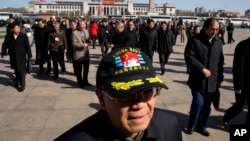China on Thursday sketched out plans for the islands it is creating in the disputed South China Sea, saying they would be used for military defense as well as to provide civilian services that would benefit other countries.
Chinese Foreign Ministry spokeswoman Hua Chunying told reporters that the reclamation and building work in the Spratly archipelago was needed partly because of the risk of typhoons in an area with a lot of shipping that is far from land.
"We are building shelters, aids for navigation, search and rescue, as well as marine meteorological forecasting services, fishery services and other administrative services'' for China and neighboring countries, Hua said.
The islands and reefs would also meet the demands for China's defense, Hua said without elaborating.
It is rare for China to give such detail about its plans for the artificial islands. The rapid reclamation taking place on seven reefs has alarmed other claimants and drawn U.S. criticism, including from Defense Secretary Ash Carter, who is visiting Japan and South Korea this week.
"The relevant construction is a matter that is entirely within the scope of China's sovereignty. It is fair, reasonable, lawful, it does not affect and is not targeted against any country. It is beyond reproach,'' Hua added.
Overlapping claims
China claims most of the South China Sea, through which $5 trillion in shipborne trade passes every year. The Philippines, Vietnam, Malaysia, Brunei and Taiwan also have overlapping claims.
All but Brunei have fortified bases in the Spratlys, which lie roughly 1,300 kilometers (800 miles) from the Chinese mainland and are much closer to the Southeast Asian claimants.
While China's new islands will not overturn U.S. military superiority in the region, workers are building ports and fuel storage depots and possibly two airstrips that experts have said would allow Beijing to project power deep into the maritime heart of Southeast Asia.
Asked about Hua's comments, U.S. State Department spokesman Jeff Rathke called the land reclamation "destabilizing'' and said it was "fueling greater anxiety within the region about China's intentions amid concerns that they might militarize outposts on disputed land features in the South China Sea.''
"We very much hope that China would recalibrate in the interests of stability and good relations in the region,'' he told reporters in Washington.
Western and Asian naval officials privately say that China could feel emboldened to try to limit air and sea navigation once the reclaimed islands are fully established.
The U.N. Convention on the Law of the Sea does not legally allow for reclaimed land to be used to demarcate 12-nautical-mile territorial zones, but some officials fear China will not feel limited by that document and will seek to keep foreign navies from passing close by.
Jin Crannog, associate dean of the School of International Studies at Beijing's Renaming University, said China probably felt it needed to give its side of the story following growing criticism from Washington over the reclamation.
"The motivation in giving an explanation is a good one, to set minds at ease,'' Jin said.
Hua's comments came hours after a Washington think tank published new satellite images that show China is quickly reclaiming land around Mischief Reef in the Spratlys within an area the Philippines regards as its exclusive economic zone.
New structures, sea walls
The work on Mischief Reef, which China occupied in 1995, is Beijing's most recent reclamation. A March 16 image published by the Center for Strategic and International Studies (CSIS) showed what it said were a chain of small artificial land formations as well as new structures, fortified sea walls and construction equipment along the reef.
Several dredgers are also present, and the entrance to the reef has been expanded, the CSIS Asia Maritime Transparency Initiative said on its website.
An image from Feb. 1 showed a Chinese amphibious transport naval vessel several hundred meters from the reef's entrance.
Surveillance photos taken of Mischief Reef in October and seen by Reuters showed no reclamation work.
Asked about Mischief Reef in light of the images, Carter said he did not want to speculate on China's plans but added that the militarization of territorial disputes in the South China Sea could lead to "dangerous incidents.''
Philippine Defense Ministry spokesman Peter Paul Galvez urged China to dismantle the work on Mischief Reef, 216 kilometers (135 miles) west of the Philippine island of Palawan, saying it would affect his country's national security.
